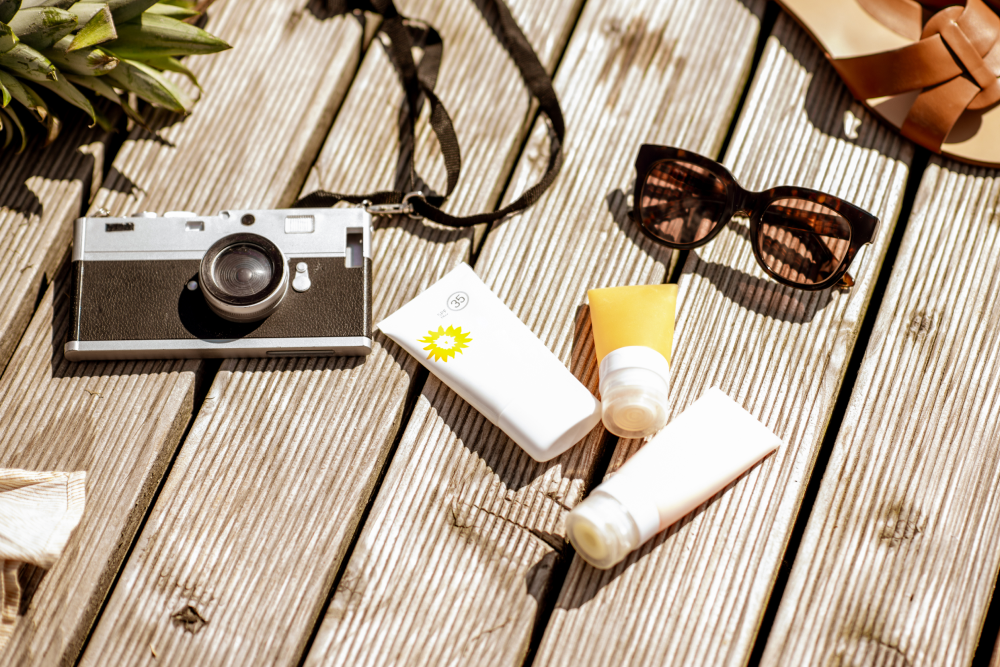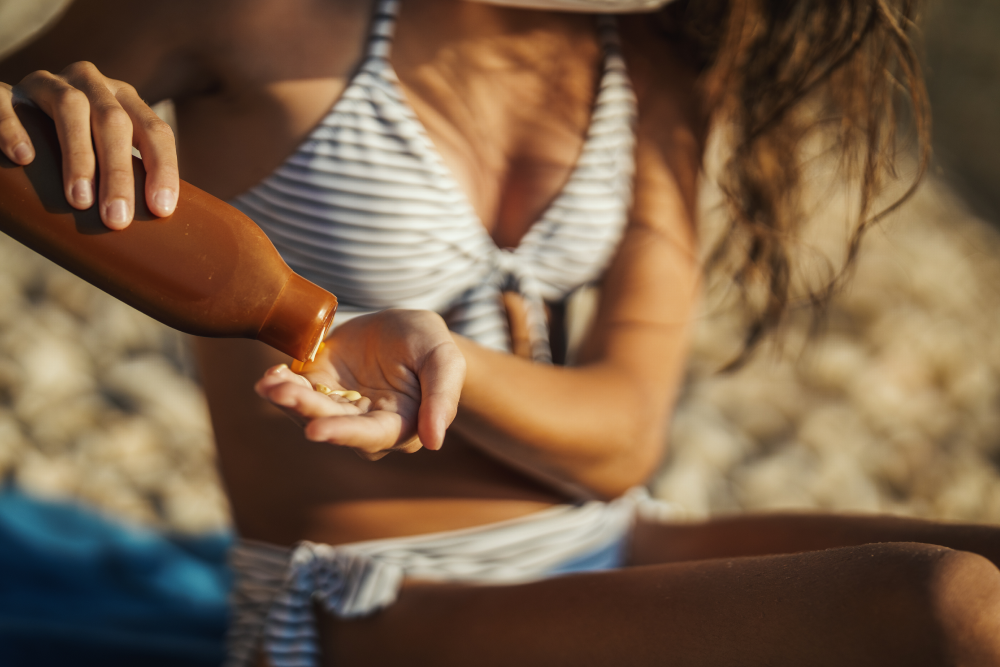
Summer holidays offer sunshine and adventure, but they can wreak havoc on your skin. From intense UV exposure to dehydrating flights, travel and warm weather, there are unique challenges for maintaining healthy, radiant skin. With proper preparation and technique, you can protect your skin while enjoying every moment of your summer adventures.
Essential Sun Protection: Beyond Basic SPF
Good quality UV protection is the cornerstone of summer skincare and preventing skin cancer. Understanding how to use sun protection effectively makes the difference between healthy skin and potential long-term damage.
Recommended Sun Safety Protocol:
- SPF Selection: Use sunscreen of at least SPF 30 with 4-star UVA protection, though SPF 50+ is recommended for extended outdoor activities
- Application Amount: At least six full teaspoons (approximately 36 grams) to cover an average adult body
- Timing: Seek shade between 11am and 3pm when the sun is strongest
- Reapplication: Every two hours and after swimming, exercising, or towelling off
Unprotected skin can be damaged by UV rays in as little as 15 minutes, yet it can take up to 12 hours for skin to show the full effects of sun damage. This delay means you might not realise you’re burning until it’s too late.

Key Areas Often Missed:
- Ears, feet, and backs of hands
- Hairline and scalp (especially if hair is thinning)
- Around sunglasses and swimwear lines
- Lips (use SPF lip balm)
Physical barriers complement sunscreen effectively. Wide-brimmed hats, UV-protective clothing, and quality sunglasses create multiple layers of defence against harmful radiation.
Hydration Inside and Out: Combat Heat and Travel Dehydration
The intense heat can dehydrate you extremely quickly, and therefore it’s really important to stay hydrated with fluids throughout the day both for your skin and your overall health.
Internal Hydration Strategy:
Sugary, alcoholic and caffeinated drinks can make you dehydrated, so water should be your primary choice.
Daily Fluid Targets:
- Normal conditions: 8-10 glasses daily
- Hot weather: 10-12 glasses daily
- Travel days: Additional 200ml per hour of flight time
- Post-sun exposure: Extra fluids to support skin repair
External Hydration Approach:
Your skin’s moisture needs change dramatically with climate and environmental conditions. Adapting your skincare routine to match these changes prevents dehydration-related skin problems.
For Humid Climates:
- Lightweight, water-based moisturisers
- Gel formulations that won’t clog pores
- Hyaluronic acid serums for deep hydration without heaviness
For Dry/Air-Conditioned Environments:
- Richer cream formulations
- Ceramide-containing products to restore barrier function
- Facial oils for overnight repair
Managing Common Summer Skin Issues
Summer brings specific skin challenges that can disrupt even the most careful holiday plans. Understanding how to prevent and treat these issues quickly ensures you can address problems before they become serious.

Summer Breakout Management:
Unfortunately, the increased heat and humidity can trigger excess oil production, leading to clogged pores and breakouts. The key is maintaining the fine line between avoiding oily skin without over-drying your skin.
Some things you can do to help avoid those summer breakouts are:
- Use oil-free, non-comedogenic sunscreens
- Gently cleansing twice daily
- Applying lightweight moisturisers to prevent over-drying
- Regularly washing hats, sunglasses, and swimwear
Here are a few beneficial ingredients to look out for in your skin care products:
- Salicylic acid for gentle pore clearing
- Niacinamide to regulate oil production
- Tea tree oil for natural antimicrobial properties
Sunburn Recovery:
Despite best prevention efforts, sunburn can still occur. Early action minimises the damage and discomfort significantly and can help with long-term skin recovery.
Things you should do immediately after getting sun burnt:
- Cool (not ice-cold) compresses for 15-20 minutes
- Ibuprofen or aspirin to reduce inflammation
- Increased fluid intake to support healing
- Avoid products containing alcohol or fragrances
And to help aid long term recovery:
- Use pure aloe vera gel for cooling and healing
- Apply gentle, fragrance-free moisturisers
- Avoid further sun exposure until healed
- Seek medical attention for severe burns with blistering or fever
Travel-Smart Skincare: Adapting Your Routine on the Go
Maintaining effective skincare while travelling requires strategic planning and smart adaptations. Your skin faces unique challenges during travel, from cabin pressure changes to different climates and water quality.
Pre-travel preparation:
Starting your skin preparation well before departure sets the foundation for healthy skin throughout your trip. Avoid introducing new products close to travel dates, as your skin may react unpredictably in unfamiliar environments.
Airplane Travel Considerations:
Cabin environments present unique challenges with extremely low humidity and recycled air. Advanced preparation can help minimise the impact on your skin. Some things to try are applying extra moisturiser before the flight, drinking regular water on the flight, and considering the use of a hydrating face mask on long haul flights.
Post-Holiday Skin Recovery: Repairing Summer Damage
Returning from summer holidays often reveals the cumulative effects of sun exposure, environmental stressors, and routine disruptions. A thoughtful recovery approach helps repair damage and restore your skin’s healthy appearance while preventing long-term consequences.

Gentle Recovery Protocol:
Your skin may be sensitised from sun exposure and environmental changes, making it more reactive than usual. Starting with gentle, restorative care prevents further irritation.
For Sun Damage and Pigmentation:
- Vitamin C serum to prevent further oxidative damage
- Gentle chemical exfoliants to encourage cell turnover
- Consistent SPF use to prevent darkening
For Texture and Sensitivity Issues:
- Ceramide-rich moisturisers to restore barrier function
- Hyaluronic acid for deep hydration
- Soothing ingredients like aloe vera or chamomile
When to Seek Professional Help:
Some post-holiday skin concerns require professional evaluation and treatment. Don’t delay seeking help if you notice concerning changes.
Red Flag Symptoms:
- New or changing moles or spots
- Persistent redness or irritation after 2-3 weeks
- Severe texture changes or scarring
- Signs of infection (warmth, pus, spreading redness)
Conclusion
The most effective skincare routine is one you’ll follow consistently. Focus on the proven basics rather than complicated regimens that are difficult to maintain while travelling. With proper preparation and knowledge, you can relax in the sun while keeping your skin healthy and protected. Stay safe and enjoy your summer!
This article is intended for informational purposes only and does not constitute medical advice. Please consult with a healthcare professional for personalised medical guidance.











